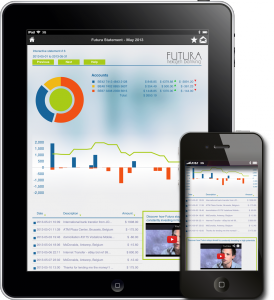
My previous blogpost was about paradigm shifts that are happening within an organization, allowing non-technical business people to graphically design documents, electronic forms, but also interactive communications for mobile devices.
In this blogpost I'll touch on another paradigm shift, but not within the organization, but in customer's minds. Let's take the financial sector, with banks and insurance companies as an example. Do the exercise and see how this also impacts your industry.
Previously, a bank customer would go to the bank employee to ask questions on the amount of money in his bank account, getting information on certain products such as loans or insurances, make investments in funds, etc. The employee would then look up information in online systems, print out the relevant documents (such as contracts, bank statements, claims forms, etc) and give them to the customer so that he could take the information home.
The last years, there is a clear shift towards customers that look up information themselves: through web banking they look at the account balance, through web forms they request a quotation for an insurance, etc. Because of the wide accessibility of mobile devices, customers just expect (even demand) that they can access those systems via mobile devices. Many transactions can be done through mobile devices, while organizations keep investing more and more money in mobile apps to deliver them.
However, when the transaction is completed, even with a mobile device, as a result typically a static document is sent to the customer: for example a statement is sent where the transaction details are shown, an insurance contract is presented, etc. Also, the followup later happens periodically with documents: an overview of an investment portfolio is sent every quarter, or every year, an yearly overview of a mortgage with the amount of capital and interests that were payed, etc.
In the past these communications where presented as documents sent via paper. In many cases today, they are already sent electronically, typically with the same layout as the paper document but then in PDF format.
Here, the paradigm shift is happening: customers are no longer content getting just static information in the form of documents, be it on paper or electronically. They want interactive communications, so that they can zoom in on individual transactions and filter the information with their personal criteria. They want to ask questions, while they're looking at the communications, they want to see videos about the topic, etc.
For Inventive Designers, this is very natural and we've been expecting this for a long time. That's why we don't speak about documents, but instead speak about communications. And with Scriptura Engage, non-technical business users can design these kinds of interactive and dynamic communications.
Why do we care? Because it is our passion to help organizations better communicate with their customers. We do that through our Scriptura Engage solution.

Add new comment